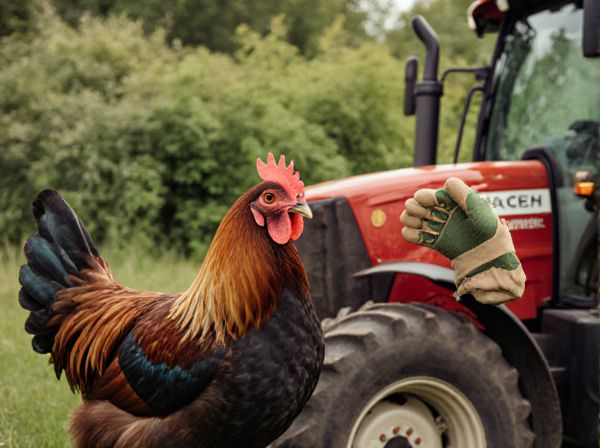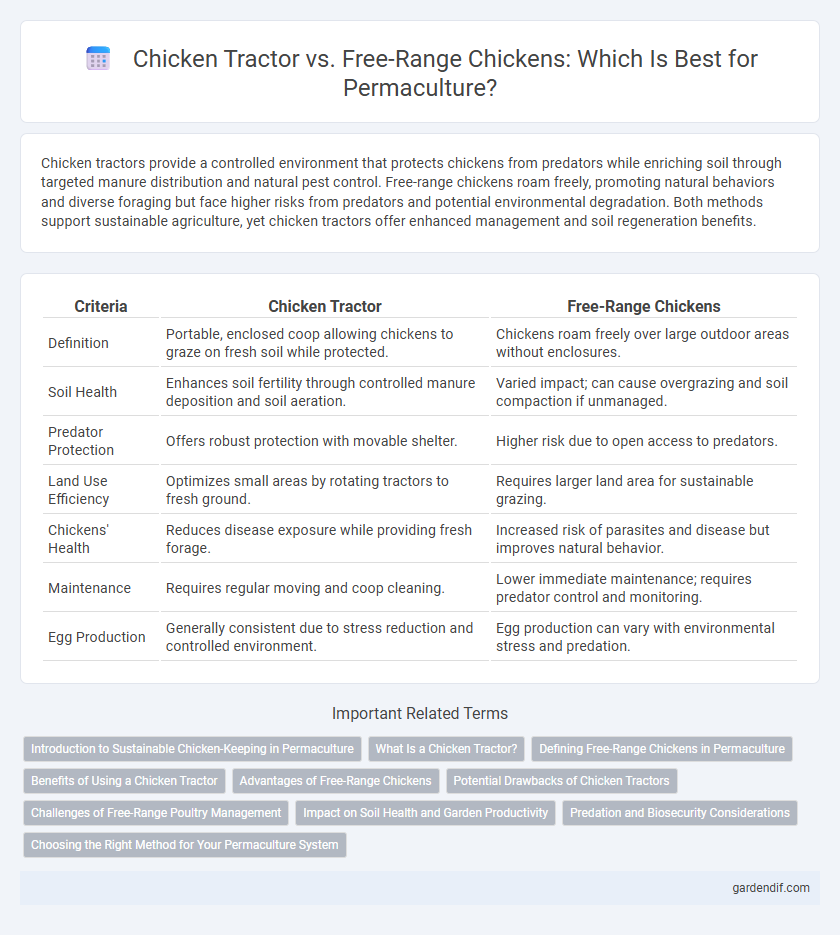
Chicken Tractor vs Free-Range Chickens Illustration
Chicken tractors provide a controlled environment that protects chickens from predators while enriching soil through targeted manure distribution and natural pest control. Free-range chickens roam freely, promoting natural behaviors and diverse foraging but face higher risks from predators and potential environmental degradation. Both methods support sustainable agriculture, yet chicken tractors offer enhanced management and soil regeneration benefits.
Table of Comparison
| Criteria | Chicken Tractor | Free-Range Chickens |
|---|---|---|
| Definition | Portable, enclosed coop allowing chickens to graze on fresh soil while protected. | Chickens roam freely over large outdoor areas without enclosures. |
| Soil Health | Enhances soil fertility through controlled manure deposition and soil aeration. | Varied impact; can cause overgrazing and soil compaction if unmanaged. |
| Predator Protection | Offers robust protection with movable shelter. | Higher risk due to open access to predators. |
| Land Use Efficiency | Optimizes small areas by rotating tractors to fresh ground. | Requires larger land area for sustainable grazing. |
| Chickens' Health | Reduces disease exposure while providing fresh forage. | Increased risk of parasites and disease but improves natural behavior. |
| Maintenance | Requires regular moving and coop cleaning. | Lower immediate maintenance; requires predator control and monitoring. |
| Egg Production | Generally consistent due to stress reduction and controlled environment. | Egg production can vary with environmental stress and predation. |
Introduction to Sustainable Chicken-Keeping in Permaculture
Chicken tractors provide a movable shelter system that enhances soil fertility and pest control by allowing chickens to graze on fresh ground regularly. Free-range chickens roam openly, promoting natural behaviors and biodiversity but require strong protection from predators. Both methods support sustainable chicken-keeping by integrating animal welfare with ecological land management in permaculture design.
What Is a Chicken Tractor?
A chicken tractor is a movable, enclosed structure designed to house chickens while allowing them to forage on fresh ground daily. This method supports soil health by evenly distributing manure and preventing overgrazing in one area. Unlike free-range systems where chickens roam unrestricted, chicken tractors offer protection from predators and environmental hazards while promoting sustainable land use.
Defining Free-Range Chickens in Permaculture
Free-range chickens in permaculture systems are allowed to roam freely over a designated outdoor area, foraging naturally for insects, seeds, and plants, which supports soil health and biodiversity. Unlike confined methods, free-range practices reduce the need for supplemental feed and promote natural pest control by enabling chickens to express innate behaviors. Managing free-range chickens requires balancing space, predator protection, and environmental impact to maintain sustainable, nutrient-rich landscapes.
Benefits of Using a Chicken Tractor
Chicken tractors offer significant advantages for sustainable farming by providing controlled grazing that enriches soil fertility through natural fertilization and pest control. This method promotes healthier chickens by reducing exposure to predators and disease compared to traditional free-range systems. Additionally, the mobility of chicken tractors allows for efficient pasture rotation, preventing overgrazing and supporting regenerative land management practices.
Advantages of Free-Range Chickens
Free-range chickens provide natural pest control by foraging on insects and weeds, promoting soil health and reducing reliance on chemical inputs. Their ability to roam freely enhances animal welfare and results in higher-quality eggs with richer nutrient profiles. This sustainable farming approach supports biodiversity and integrates well with permaculture principles, fostering a balanced ecosystem.
Potential Drawbacks of Chicken Tractors
Chicken tractors can limit natural foraging behavior compared to free-range systems, potentially reducing the nutritional diversity of chicken diets. They require regular relocation to prevent soil depletion and parasite buildup, increasing labor demands for farmers. The confined space may also elevate stress levels and reduce overall chicken welfare compared to fully free-range environments.
Challenges of Free-Range Poultry Management
Free-range poultry management faces challenges such as increased vulnerability to predators, inconsistent foraging quality, and greater exposure to diseases. In contrast to chicken tractors that limit movement but enhance protection, free-range chickens require robust fencing and frequent health monitoring to mitigate risks. Balancing natural behavior with safety concerns remains a key difficulty in free-range systems.
Impact on Soil Health and Garden Productivity
Chicken tractors enhance soil health by allowing controlled foraging, which aerates the soil and distributes natural fertilizers evenly, promoting nutrient-rich garden beds. Free-range chickens contribute to pest control and organic matter integration but may cause uneven soil disturbance and localized overgrazing, potentially harming soil structure. Using chicken tractors strategically increases garden productivity through improved soil aeration and nutrient cycling compared to unrestricted free-range systems.
Predation and Biosecurity Considerations
Chicken tractors offer enhanced protection against predation by providing a movable, enclosed environment that limits access to predators like hawks, foxes, and raccoons. Free-range chickens benefit from natural behaviors but face higher risks from predators due to limited containment and exposure during foraging. Biosecurity is improved in chicken tractors through controlled conditions and easier management of disease vectors, while free-range systems require vigilant monitoring to prevent exposure to pathogens and wild bird droppings.
Choosing the Right Method for Your Permaculture System
Chicken tractors offer controlled grazing, enabling soil enrichment and pest reduction within permaculture gardens, while free-range chickens encourage natural foraging but pose challenges with potential overgrazing and predator exposure. Selecting the right method depends on your land size, desired control over poultry movement, and specific ecosystem goals, such as enhancing soil fertility or maintaining native vegetation. Integrating chicken tractors can optimize nutrient cycling and plant health, whereas free-range systems support a more natural behavior for chickens, demanding careful predator management and rotational grazing strategies.
Chicken Tractor vs Free-Range Chickens Infographic

 gardendif.com
gardendif.com